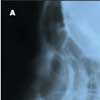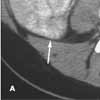
A 58-year-old man presents with exertionaldyspnea of 6 weeks’ duration, adry cough for 2 weeks, and decreasedappetite. He denies fever, chills, sputumproduction, hemoptysis, cigarette smoking,and significant weight loss. Thepatient, a retired electrician, was exposedto asbestos 20 years earlier.




















































































































































































































































































